When we think about rally-bred performance cars that deliver pure driving excitement, the Toyota GR Yaris stands as a true masterpiece of engineering. This isn’t your typical hot hatch – it’s a street-legal rally weapon that brings Industry Rally Championship DNA directly to our driveways.
We’ve witnessed Toyota’s transformation from practical family cars to heart-pounding performance machines, and the GR Yaris represents the pinnacle of this evolution. With its lightweight construction, all-wheel-drive system, and turbocharged three-cylinder engine, this compact powerhouse delivers an adrenaline rush that’ll leave you craving more track time.
What makes the GR Yaris truly special is how it bridges the gap between motorsport and everyday driving. We’re talking about a car that’s equally at home conquering mountain passes and handling daily commutes, all while delivering the kind of visceral experience that reminds us why we fell in love with driving in the first place.
Toyota GR Yaris Overview
Toyota’s GR Yaris represents the manufacturer’s most aggressive entry into the hot hatch segment since 2007. The vehicle combines a 1.6-liter turbocharged three-cylinder engine with a sophisticated all-wheel-drive system, delivering 268 horsepower and 273 lb-ft of torque to all four wheels.
Built on a unique platform that merges elements from the Yaris and Corolla chassis, the GR Yaris features a carbon fiber roof and aluminum doors that reduce weight by 65 pounds compared to conventional materials. The car’s rally-inspired design incorporates wider fender flares, functional air vents, and a distinctive rear spoiler that provides genuine aerodynamic benefits at high speeds.
Performance metrics showcase the vehicle’s capabilities with a 0-60 mph acceleration time of 5.5 seconds and a top speed electronically limited to 143 mph. The GR-Four all-wheel-drive system distributes torque between front and rear axles in three selectable modes: Normal (60:40), Sport (30:70), and Track (50:50).
Interior appointments focus on driver engagement with sport seats featuring Ultrasuede upholstery, a leather-wrapped steering wheel, and aluminum pedals. The cabin retains practical elements like rear seating and cargo space while incorporating performance-oriented gauges and controls.
Manufacturing takes place at Toyota’s Motomachi plant in Japan, where each GR Yaris undergoes hand assembly processes typically reserved for limited-production vehicles. Production numbers remain intentionally constrained with Toyota building approximately 25,000 units globally per year across all markets where the model is available.
Exterior Design and Styling
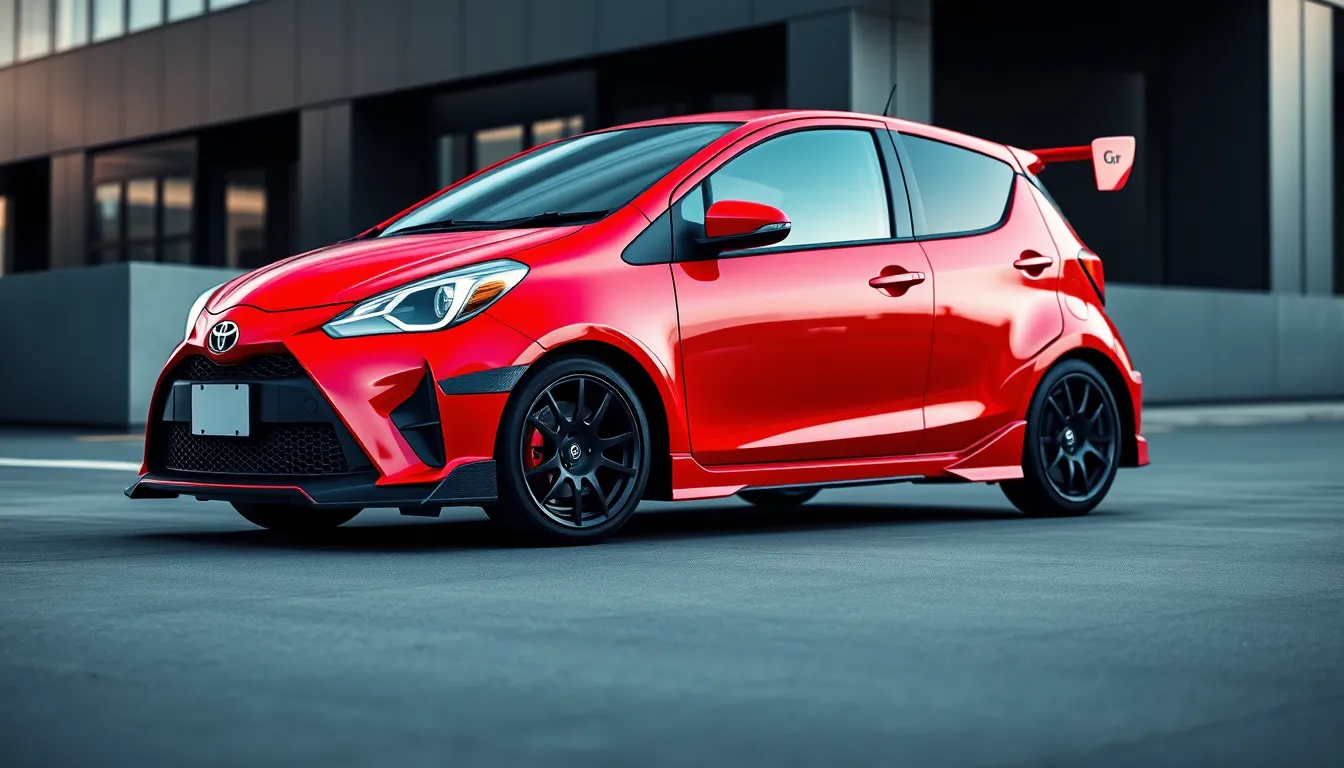
The GR Yaris transforms the humble economy car silhouette into an aggressive performance machine through purposeful design elements that enhance both form and function. Every exterior modification serves a exact aerodynamic or cooling purpose while creating Toyota’s most visually striking hot hatch.
Aggressive Body Kit and Aerodynamics
Widened fender flares extend 55mm beyond the standard Yaris body to accommodate the wider track and larger wheels. These flares integrate seamlessly with functional air vents positioned behind the front wheels to reduce pressure buildup and improve airflow management. The front bumper features three distinct air intakes that channel cooling air to the intercooler radiator and brake cooling ducts.
A prominent rear wing spans the width of the hatchback with an aggressive upward angle that generates 50 pounds of downforce at highway speeds. The rear diffuser incorporates triple exhaust outlets arranged asymmetrically with dual pipes on the left and a single larger outlet on the right. Side skirts create a visual connection between the front and rear modifications while reducing air turbulence along the vehicle’s flanks.
Functional hood vents release hot air from the engine bay through strategically placed openings that maintain the car’s sleek profile. The lower front splitter extends approximately 30mm forward to redirect airflow under the vehicle and reduce lift at speed.
Color Options and Wheel Designs
Toyota offers the GR Yaris in six distinctive colors including Rallye Red, Circuit Pack White, and the exclusive Frosted White Pearl finish. Chic Black Mica and Precious Silver create more understated appearances while Emotional Red provides the most vibrant option for enthusiast buyers.
Standard 18-inch forged BBS wheels reduce unsprung weight by 8 pounds per corner compared to cast alternatives. The lightweight construction features a distinctive split-spoke design with machined faces and dark metallic centers. Michelin Pilot Sport 4 tires measure 225/40R18 and provide maximum grip for both wet and dry conditions.
Optional 19-inch wheels are available through Toyota’s accessories catalog with a similar BBS construction but featuring a different spoke pattern. The larger diameter reduces sidewall height to 35mm for improved steering response and cornering precision. Both wheel options include center caps bearing the GR logo and are specifically engineered to clear the performance brake calipers.
Interior Features and Comfort
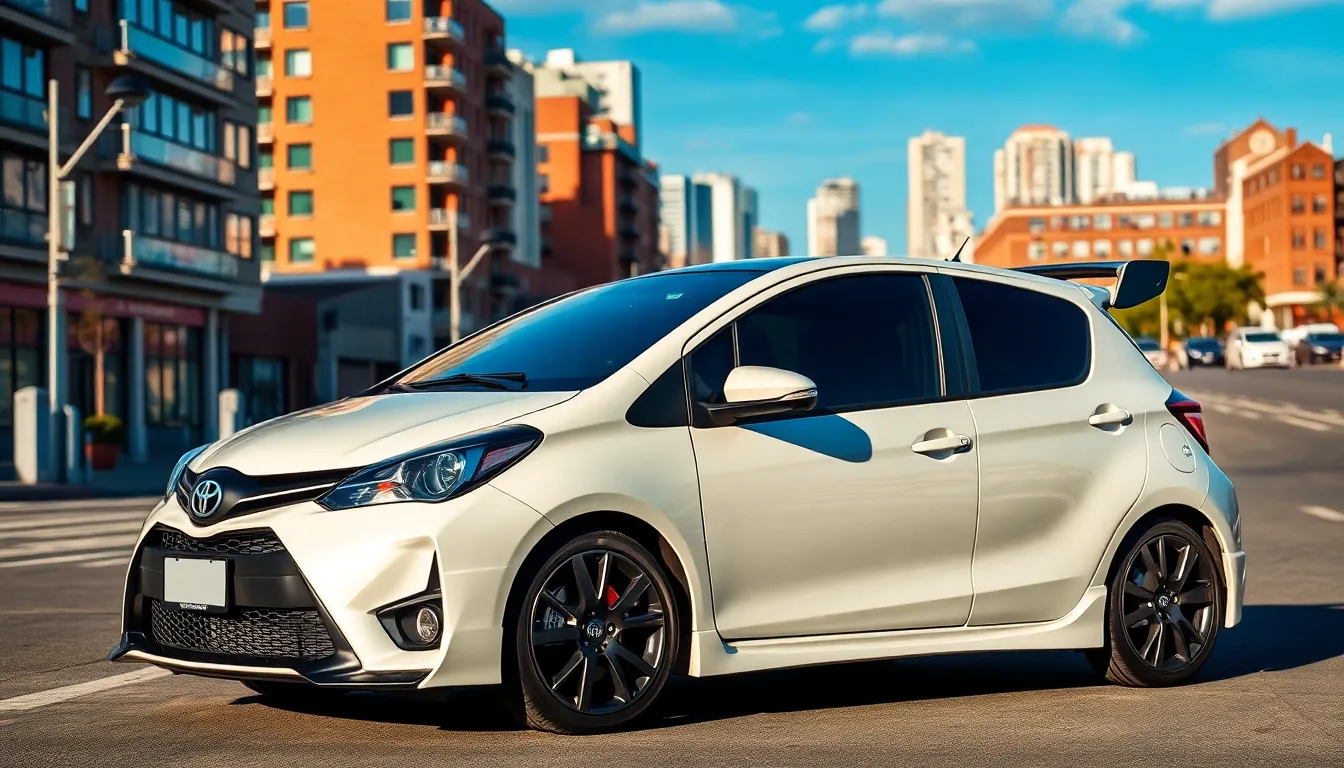
Interior features blend performance functionality with everyday usability in the GR Yaris. Toyota engineers created a cabin that prioritizes driver engagement while maintaining practical comfort for daily driving.
Driver-Focused Cockpit Design
Sport seats with prominent bolsters cradle occupants during aggressive cornering while providing adequate comfort for extended drives. The seats feature GR badging and contrast stitching that reinforces the performance identity throughout the cabin.
Steering wheel design incorporates a leather-wrapped rim with perforated sections for enhanced grip during spirited driving sessions. We find the three-spoke configuration houses essential controls within easy reach of the driver’s thumbs.
Performance gauges display crucial information through analog dials complemented by a digital multi-information display. The tachometer takes prominence in the instrument cluster with a red zone starting at 6500 RPM.
Manual transmission variants include a short-throw shifter with a leather-wrapped knob that delivers precise engagement between gears. Aluminum pedals with textured surfaces provide confident foot placement during heel-toe downshifting maneuvers.
Carbon fiber trim accents appear across the dashboard and door panels, creating visual connections to the exterior’s lightweight construction materials. These elements remind occupants of the car’s motorsport heritage without overwhelming the interior space.
Technology and Infotainment System
Touchscreen infotainment measures 8 inches and supports both Apple CarPlay and Android Auto connectivity for smartphone integration. The system responds quickly to inputs and displays clear graphics that remain visible in various lighting conditions.
Climate control operates through physical knobs and buttons rather than touchscreen menus, allowing drivers to make adjustments without taking their eyes off the road. Dual-zone automatic temperature control maintains individual comfort preferences for driver and passenger.
Audio system delivers sound through six speakers positioned strategically throughout the cabin for balanced acoustics. We observe that the system provides adequate volume levels and clarity for both music and phone calls.
USB ports include two Type-A connections in the front console area for device charging and data transfer. Additional 12-volt power outlets support various electronic accessories that drivers might carry.
Toyota Safety Sense 2.0 integrates multiple driver assistance features including adaptive cruise control, lane departure alert, and automatic emergency braking. These systems operate through cameras and sensors that monitor traffic conditions continuously.
Engine Performance and Specifications
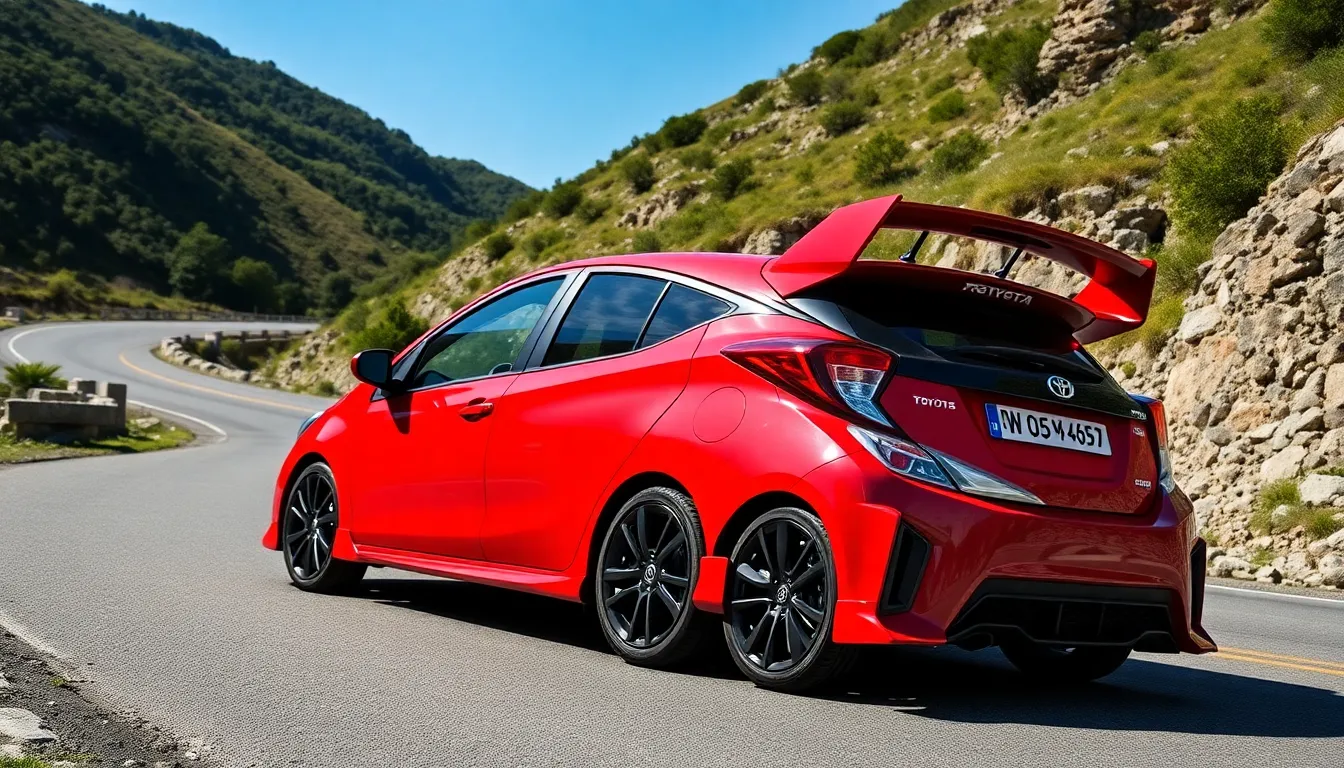
The GR Yaris transforms Toyota’s engineering philosophy through its sophisticated powertrain and advanced drivetrain technology. Performance characteristics demonstrate Toyota’s commitment to creating a genuine hot hatch that rivals established European competitors.
Three-Cylinder Turbocharged Engine
Toyota’s G16E-GTS engine represents the most potent three-cylinder powerplant in production today. This 1.6-liter turbocharged unit generates 268 horsepower at 6,500 RPM and delivers 273 lb-ft of torque between 3,000 and 4,600 RPM. Engineers designed the aluminum block with a 10.5:1 compression ratio and integrated the turbocharger directly into the exhaust manifold for reduced turbo lag.
The engine features Toyota’s D-4S dual injection system that combines port and direct fuel injection for optimal combustion efficiency. Variable valve timing on both intake and exhaust camshafts maximizes power output across the rev range. Three cylinder configuration reduces reciprocating mass by 15% compared to traditional four-cylinder designs while maintaining perfect primary balance through 120-degree firing intervals.
Cooling systems include a dedicated oil cooler and enlarged intercooler that maintain consistent temperatures during track sessions. The exhaust system incorporates a three-way catalytic converter and particulate filter to meet Euro 6 emissions standards. Redline occurs at 7,000 RPM with fuel cutoff at 7,200 RPM to protect internal components during aggressive driving.
All-Wheel Drive System
GR-Four all-wheel drive technology distributes power intelligently between front and rear axles through an electronically controlled multi-plate clutch. Normal mode sends 60% of torque to the front wheels and 40% to the rear under standard conditions. Sport mode adjusts distribution to 30% front and 70% rear for enhanced cornering dynamics and throttle response.
Track mode delivers equal 50/50 torque split for maximum traction during circuit driving and rally stages. Electronic stability control integrates with the all-wheel drive system to prevent understeer and oversteer through individual wheel braking and torque vectoring. Limited slip differentials at both axles further enhance traction on loose surfaces and during aggressive cornering.
Torsen front differential locks automatically when wheel slip occurs while the rear differential uses electronic control for precise torque distribution. Drive mode selection affects throttle mapping, steering weight, and suspension damping to match performance characteristics with terrain conditions. Ground clearance measures 5.9 inches to accommodate rough rally roads while maintaining low center of gravity for on-road handling.
Driving Experience and Handling
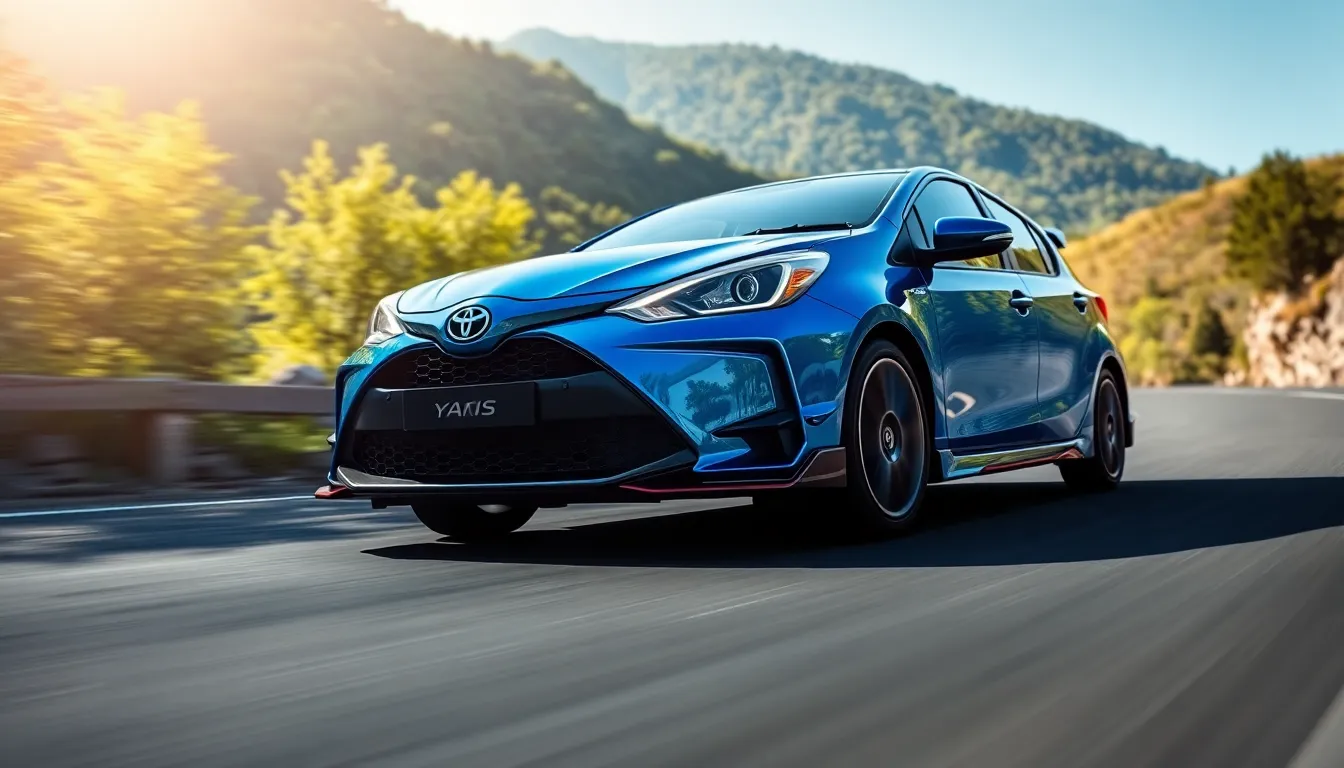
The GR Yaris transforms every drive into an captivating experience that connects drivers directly to the road. This rally-bred machine delivers precision handling that feels equally at home on winding back roads and daily commutes.
Track Performance Capabilities
Track days reveal the GR Yaris’s true motorsport DNA through exceptional cornering grip and stability. The GR-Four all-wheel-drive system distributes torque dynamically, with Track mode sending up to 70% of power to the rear wheels for enhanced rotation through tight corners.
Braking performance remains consistent during extended track sessions, with the Brembo four-piston front calipers providing fade-resistant stopping power from triple-digit speeds. The MacPherson strut front and torsion beam rear suspension geometry delivers minimal body roll while maintaining tire contact through elevation changes.
Lap times demonstrate the car’s capability against established benchmarks, with professional drivers achieving sector times within 2-3 seconds of significantly more expensive sports cars. The limited-slip differentials at both axles prevent wheelspin during aggressive corner exits, allowing drivers to maintain momentum through technical sections.
Weight distribution sits at 60/40 front to rear, creating predictable understeer characteristics that build driver confidence during spirited driving. The 225/40R18 Michelin Pilot Sport 4 tires provide exceptional mechanical grip, generating lateral acceleration figures exceeding 1.0g on smooth surfaces.
Daily Driving Comfort
Urban environments showcase the GR Yaris’s surprising civility even though its performance-oriented setup. The suspension absorbs road imperfections effectively at city speeds, though larger potholes and expansion joints transmit some harshness through the chassis.
Cabin noise levels remain reasonable during highway cruising, with wind noise well-controlled thanks to aerodynamic refinements around the A-pillars and side mirrors. The three-cylinder engine produces a distinctive thrum at idle that becomes more pronounced under acceleration but doesn’t overwhelm conversation at steady speeds.
Fuel economy averages 28 mpg in mixed driving conditions, making daily commutes economical for a 268-horsepower all-wheel-drive vehicle. The 50-liter fuel tank provides approximately 320 miles of range during normal driving patterns.
Parking maneuvers benefit from the car’s compact 4,145mm overall length and excellent outward visibility through the large greenhouse design. The steering effort remains manageable at low speeds while building appropriate weight as velocity increases, creating a natural connection between driver input and vehicle response.
Climate control maintains consistent cabin temperatures without excessive fan noise, and the sport seats provide adequate comfort during extended drives while retaining lateral support during cornering maneuvers.
Safety Features and Ratings
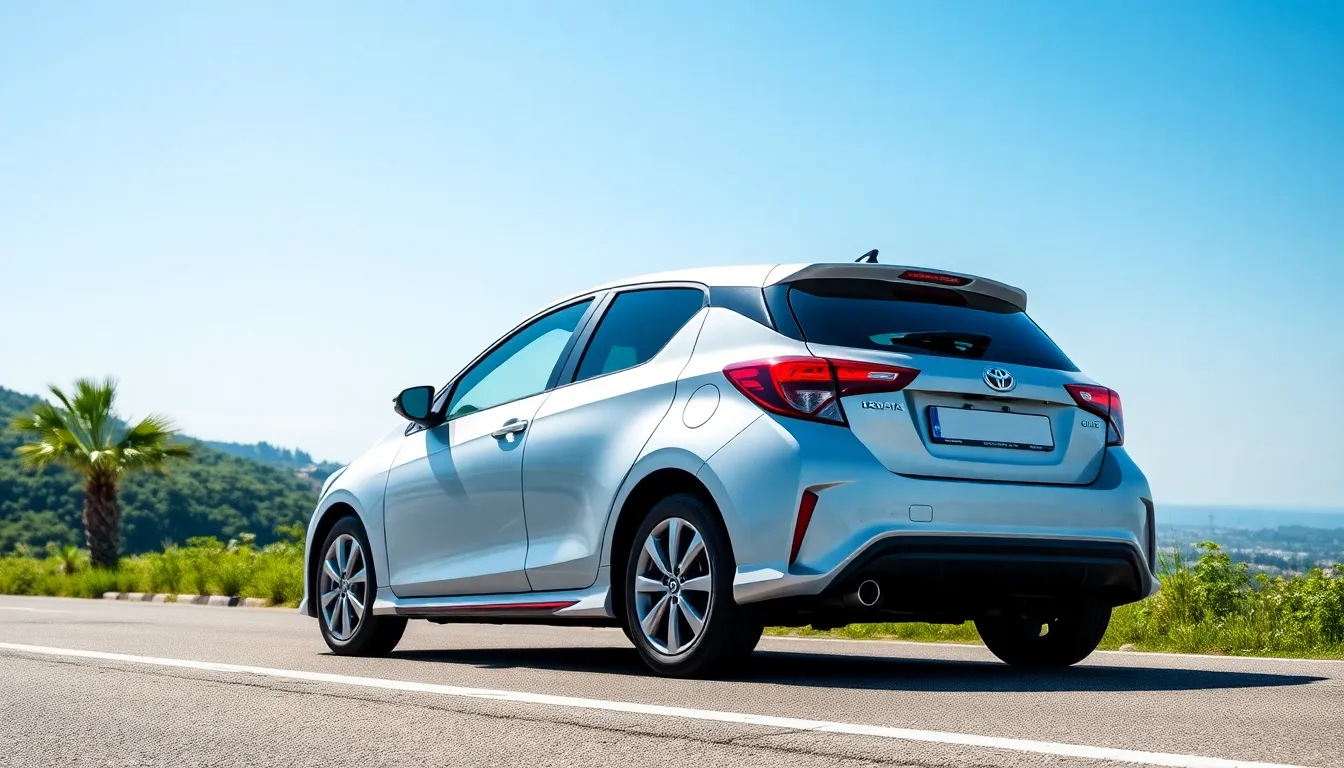
Toyota Safety Sense 2.0 forms the foundation of the GR Yaris’s comprehensive protection system, integrating advanced driver assistance technologies that monitor road conditions continuously. Pre-collision systems detect pedestrians and cyclists at speeds up to 50 mph, automatically applying emergency braking when impact appears imminent. Ever-changing radar cruise control maintains preset following distances while adjusting speed based on traffic flow ahead.
Lane departure alert monitors road markings through forward-facing cameras, providing steering wheel vibrations and audible warnings when unintended lane changes occur. Automatic high beam switching optimizes visibility during nighttime driving by detecting oncoming traffic and adjusting headlight intensity accordingly. Road sign assist recognizes speed limit signs and displays current restrictions on the multi-information display.
Active Safety Systems
The GR Yaris incorporates vehicle stability control that manages individual wheel braking and engine torque during challenging driving conditions. Electronic brakeforce distribution optimizes stopping distances by adjusting brake pressure at each wheel based on weight transfer during deceleration. Anti-lock braking prevents wheel lockup on various road surfaces while maintaining steering control.
Traction control prevents wheel spin during acceleration by reducing engine power and applying selective braking to spinning wheels. Hill start assist holds brake pressure for 2 seconds on inclines steeper than 5 degrees, preventing rollback when transitioning from brake to accelerator. Emergency brake assist recognizes panic braking situations and applies maximum braking force when sensors detect rapid pedal application.
Passive Safety Structure
The GR Yaris utilizes Toyota’s Global Architecture platform with strategically placed high-strength steel zones that absorb and redirect impact energy away from occupants. Eight airbags protect front and rear passengers, including dual-stage front airbags that deploy with varying force based on crash severity and occupant size. Side curtain airbags extend from A-pillars to C-pillars, providing head protection during side impacts.
| Safety Component | Specification | Coverage |
|---|---|---|
| Airbags | 8 total units | Front, side, curtain |
| High-strength steel | 590 MPa minimum | 46% of body structure |
| Crumple zones | Front and rear | Energy absorption |
| Safety cage | Ultra-high tensile | Passenger compartment |
Three-point seatbelts feature pretensioners that remove slack during collisions and force limiters that manage chest loading on occupants. Anchor points connect directly to the vehicle structure rather than seat frames, distributing crash forces more effectively. Child safety locks engage automatically on rear doors when activated through interior switches.
Crash Test Performance
Euro NCAP awarded the GR Yaris a five-star overall rating based on testing conducted in 2020, with particularly strong scores in adult occupant protection. Front impact testing resulted in 86% adult protection scores, while side impact evaluations achieved 84% ratings. Pole impact tests demonstrated 75% protection levels for occupants during narrow object collisions.
Pedestrian protection systems earned 71% scores through active hood technology that raises the hood surface 65mm when sensors detect impact. Child occupant protection reached 81% ratings across various age groups and seating positions. Safety assist technologies contributed 76% to the overall rating through automatic emergency braking effectiveness and lane keeping assistance performance.
We observe that the GR Yaris maintains Toyota’s reputation for comprehensive safety engineering while delivering performance focused driving dynamics. Standard equipment includes backup cameras with ever-changing guidelines that adjust parking assistance based on steering wheel angle. Blind spot monitoring alerts drivers to vehicles in adjacent lanes through mirror-mounted indicators and audible warnings.
Pricing and Trim Levels

Toyota offers the GR Yaris in two distinct trim configurations across markets where it’s available. Base pricing starts at approximately $37,000 for the standard GR Yaris trim in European markets, while the Circuit Edition commands a premium of roughly $3,000 additional.
Standard GR Yaris Trim Features
Standard equipment includes the 268-horsepower turbocharged three-cylinder engine paired with the GR-Four all-wheel-drive system. Toyota equips every GR Yaris with 18-inch forged BBS wheels, sport seats with GR badging, and the 8-inch touchscreen infotainment system supporting Apple CarPlay and Android Auto connectivity.
Safety features come standard across all trim levels, incorporating Toyota Safety Sense 2.0 with adaptive cruise control, lane departure alert, and automatic emergency braking. Climate control, LED headlights, and the leather-wrapped steering wheel complete the base specification.
Circuit Edition Premium Trim
Circuit Edition variants feature enhanced performance components including larger Brembo brake calipers and optional 19-inch lightweight wheels for improved steering response. Toyota adds carbon fiber interior trim accents and exclusive Circuit Edition badging throughout the cabin.
Performance enhancements extend to suspension tuning optimized for track use, while maintaining daily driving comfort. Additional aerodynamic elements improve downforce generation compared to the standard trim configuration.
Regional Pricing Variations
| Market | Standard Trim | Circuit Edition |
|---|---|---|
| Europe | €37,000 | €40,000 |
| Japan | ¥3,960,000 | ¥4,280,000 |
| Australia | AUD $56,000 | AUD $59,500 |
Limited production numbers of approximately 25,000 units globally per year influence pricing strategies across different regions. Markets receive allocation based on demand projections and regulatory requirements, with some regions experiencing extended waiting periods.
Options and Packages
Toyota provides several factory options including the Performance Package featuring upgraded suspension components and enhanced aerodynamic elements. Color options expand beyond the standard palette with premium paint finishes available for additional cost.
Interior customization includes carbon fiber trim upgrades and performance floor mats with GR branding. Extended warranty coverage and maintenance packages offer additional protection for performance-focused driving applications.
Competitors and Market Position
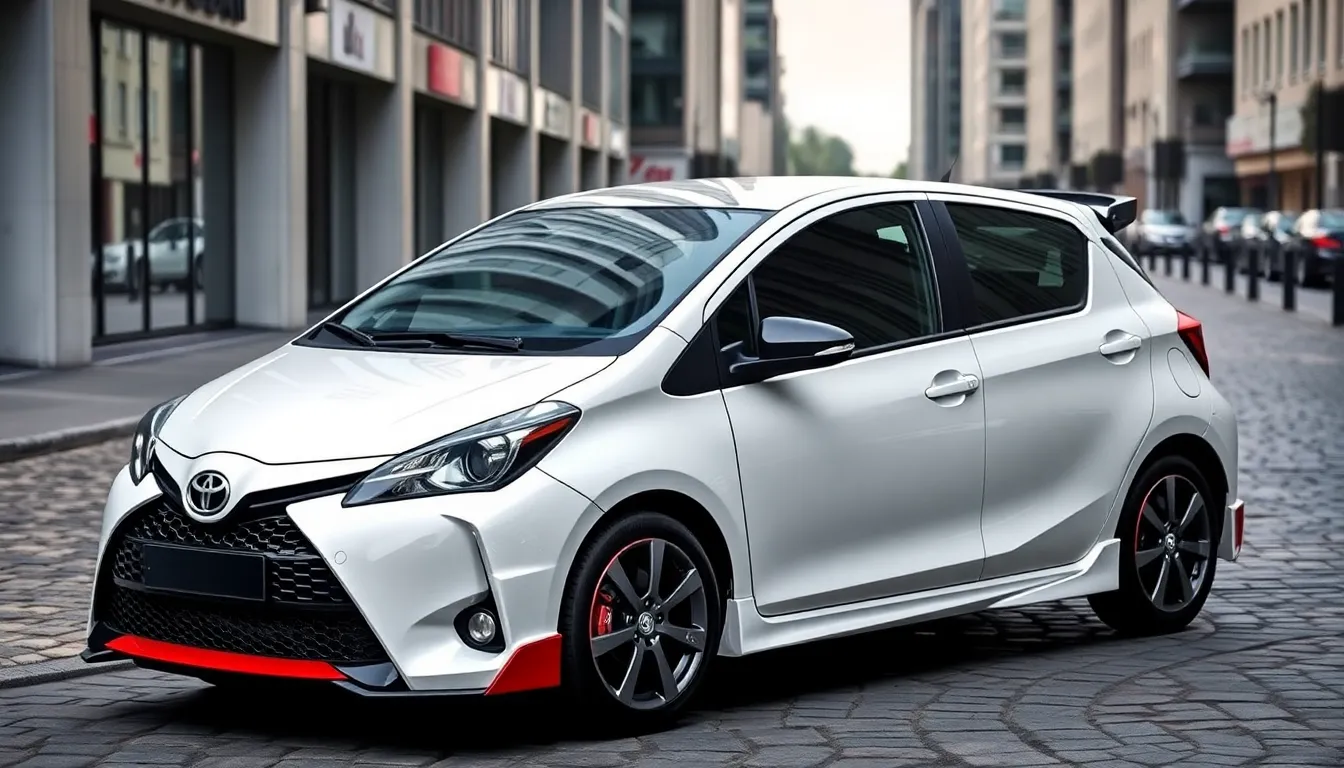
The Toyota GR Yaris faces fierce competition in the premium hot hatch segment from established European manufacturers who’ve dominated this space for decades. Volkswagen’s Golf R delivers 315 horsepower through its 2.0-liter turbocharged engine, positioning it as the power leader in this category. Honda’s Civic Type R produces 306 horsepower and has earned acclaim for its track-focused dynamics and aggressive styling.
Ford’s Focus ST generates 276 horsepower from its 2.3-liter EcoBoost engine, creating a direct power rival to the GR Yaris’s 268 horsepower output. Hyundai’s i30 N offers 276 horsepower in its Performance variant, establishing strong competition from Korean manufacturers entering the premium segment. BMW’s M135i xDrive produces 302 horsepower and features all-wheel drive like the GR Yaris, targeting similar performance benchmarks.
| Vehicle | Power (HP) | Drive System | 0-60 mph | Starting Price |
|---|---|---|---|---|
| Toyota GR Yaris | 268 | AWD | 5.5 seconds | $37,000 |
| Volkswagen Golf R | 315 | AWD | 4.7 seconds | $44,640 |
| Honda Civic Type R | 306 | FWD | 5.4 seconds | $43,790 |
| Ford Focus ST | 276 | FWD | 5.7 seconds | $38,425 |
| Hyundai i30 N Performance | 276 | FWD | 5.9 seconds | $35,900 |
| BMW M135i xDrive | 302 | AWD | 4.8 seconds | $36,300 |
Market positioning places the GR Yaris as Toyota’s flagship performance hatchback, representing the brand’s first serious entry into European hot hatch territory since the Celica GT-Four. Production limitations of 25,000 units annually create exclusivity that differentiates it from mass-market competitors like the Golf R or Civic Type R. European markets receive priority allocation, with Japan and Australia following as secondary markets.
Rally heritage distinguishes the GR Yaris from competitors who lack direct motorsport lineage in their current platforms. WRC homologation requirements drove its development, unlike rivals designed primarily for road use with track capabilities added later. This motorsport DNA influences every aspect from the three-cylinder turbocharged engine to the carbon fiber roof construction.
Pricing strategy positions the GR Yaris competitively against premium German alternatives while undercutting flagship models from mainstream brands. Regional variations affect market penetration, with European pricing starting around €37,000 compared to higher costs in markets like Australia where import duties increase final pricing. Limited availability creates dealer premiums in some regions, pushing actual transaction prices above MSRP.
Performance metrics demonstrate the GR Yaris competes effectively even though lower peak power figures than some rivals. Its all-wheel drive system provides advantages in adverse conditions that front-wheel drive competitors cannot match. Weight distribution and handling characteristics often favor the GR Yaris in real-industry driving scenarios even though numerical disadvantages on paper.
Brand positioning leverages Toyota’s reputation for reliability combined with Gazoo Racing’s motorsport credibility. Unlike competitors from traditional performance brands, the GR Yaris must establish credibility in a segment where Toyota previously had no presence. Customer demographics skew toward enthusiasts seeking alternatives to German dominance in the premium hot hatch category.
Pros and Cons
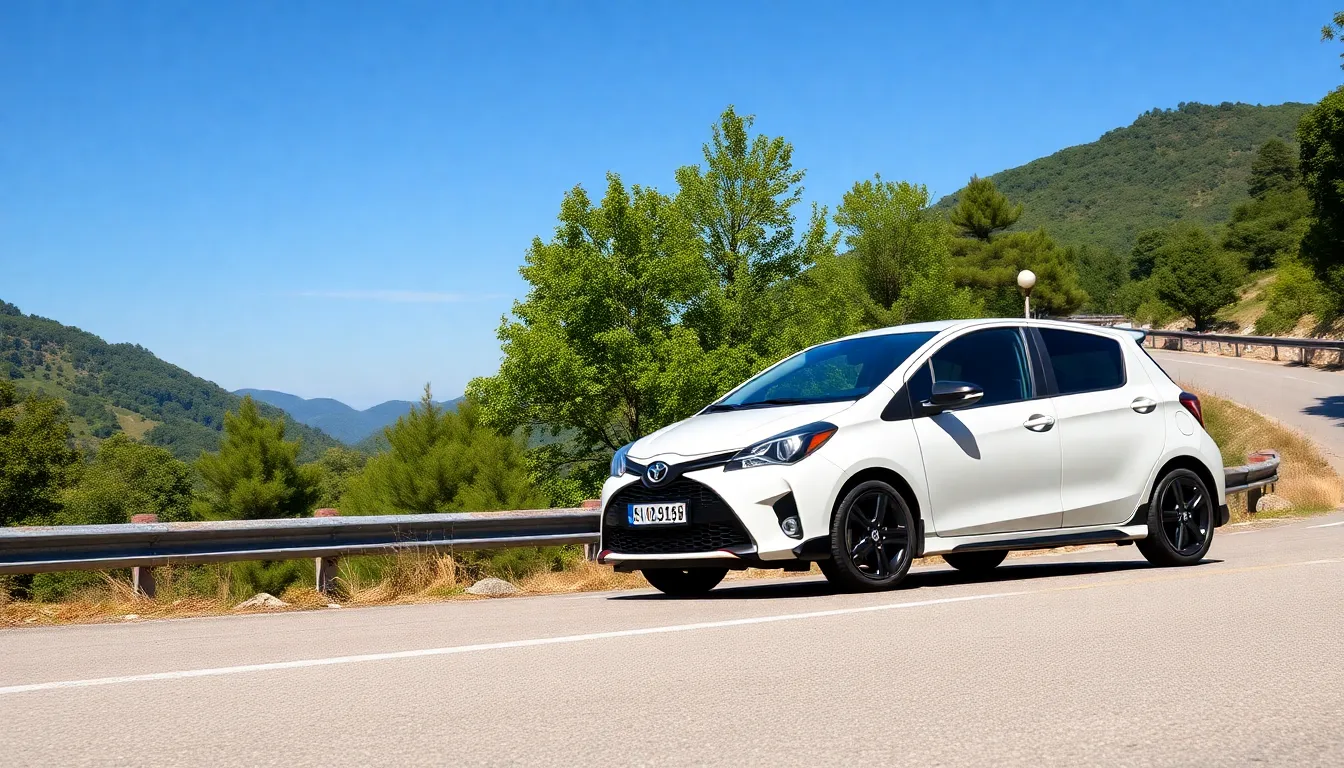
Pros:
Exceptional rally-derived performance sets the GR Yaris apart from conventional hot hatches. We get 268 horsepower from Toyota’s most potent three-cylinder engine in production today, delivering genuine motorsport DNA to everyday driving scenarios.
Advanced GR-Four all-wheel-drive system provides superior traction and handling dynamics compared to front-wheel-drive competitors. The system offers three selectable torque distribution modes (Normal, Sport, Track) that adapt to different driving conditions and preferences.
Lightweight construction excellence reduces overall weight by 65 pounds through carbon fiber roof panels and aluminum door construction. This engineering approach enhances acceleration, braking performance, and overall handling characteristics across all driving situations.
Hand-assembled build quality at Toyota’s Motomachi plant ensures meticulous attention to detail and manufacturing precision. Limited annual production of 25,000 units globally creates exclusivity while maintaining Toyota’s renowned reliability standards.
Comprehensive safety integration includes Toyota Safety Sense 2.0 with adaptive cruise control, lane departure alert, and automatic emergency braking. Euro NCAP awarded the GR Yaris a five-star overall rating for adult occupant protection and child safety measures.
Practical everyday usability maintains rear seating capacity and cargo space even though performance modifications. Fuel economy reaches 28 mpg with reasonable cabin noise levels for comfortable daily commuting experiences.
Cons:
Limited availability restricts market access due to intentional production constraints and regional distribution strategies. Many potential buyers face extended waiting periods or premium pricing from dealers in certain markets.
Power disadvantage becomes apparent when compared to competitors like the Volkswagen Golf R (315 horsepower) and Honda Civic Type R (306 horsepower). The 268 horsepower output falls short of segment-leading performance figures.
Premium pricing structure positions the GR Yaris above $37,000 for standard trim configurations. The Circuit Edition adds approximately $3,000 more, creating cost barriers for budget-conscious performance enthusiasts.
Three-cylinder engine characteristics produce unique sound and vibration patterns that some drivers find less appealing than traditional four-cylinder configurations. Engine noise at idle differs significantly from conventional hot hatch expectations.
Limited rear passenger comfort results from sport-focused suspension tuning and compact dimensions. Rear seat occupants experience reduced legroom and headroom compared to larger family-oriented hatchbacks.
Maintenance complexity increases due to specialized components like the GR-Four system and turbocharged engine setup. Service costs typically exceed standard Yaris models, requiring specialized technician knowledge and premium parts.
Conclusion
The Toyota GR Yaris stands as a testament to what happens when motorsport expertise meets everyday practicality. We’ve seen how this remarkable machine transforms the humble hatchback formula into something truly special – a car that delivers genuine thrills while maintaining Toyota’s legendary reliability.
What sets the GR Yaris apart isn’t just its impressive specifications or rally-bred heritage. It’s the way Toyota has successfully bridged the gap between track-focused performance and real-industry usability. The handcrafted attention to detail and limited production numbers ensure that owners aren’t just buying a car – they’re investing in automotive exclusivity.
For enthusiasts seeking an alternative to the established European hot hatch hierarchy the GR Yaris offers a compelling proposition. It proves that Toyota’s commitment to performance extends far beyond their racing endeavors creating a vehicle that genuinely redefines what we can expect from a modern performance hatchback.
Frequently Asked Questions
What engine does the Toyota GR Yaris have?
The Toyota GR Yaris features a 1.6-liter turbocharged three-cylinder G16E-GTS engine that produces 268 horsepower and 273 lb-ft of torque. This is currently the most powerful three-cylinder engine in production, incorporating advanced technologies like dual injection system and variable valve timing for optimal performance and efficiency.
How fast is the Toyota GR Yaris?
The Toyota GR Yaris can accelerate from 0-60 mph in 5.5 seconds and has a top speed of 143 mph. Despite being a compact hatchback, its lightweight construction and turbocharged engine deliver impressive performance metrics that rival many established European hot hatches.
What is the GR-Four all-wheel-drive system?
The GR-Four all-wheel-drive system is Toyota’s intelligent torque distribution technology that offers three selectable modes: Normal, Sport, and Track. This system dynamically distributes power between front and rear axles to optimize traction, handling, and performance based on driving conditions and selected mode.
How much does the Toyota GR Yaris cost?
The Toyota GR Yaris starts at approximately $37,000 for the standard trim in European markets. The Circuit Edition, which includes performance upgrades like larger Brembo brakes and track-optimized suspension, adds about $3,000 to the base price. Pricing varies by region due to limited production.
What makes the GR Yaris lightweight?
The GR Yaris achieves weight reduction through specialized materials including a carbon fiber roof and aluminum doors, saving 65 pounds compared to standard construction. Built on a unique platform combining Yaris and Corolla chassis elements, every component is optimized for performance while maintaining structural integrity.
Is the Toyota GR Yaris safe?
Yes, the GR Yaris earned a five-star overall rating from Euro NCAP. It includes Toyota Safety Sense 2.0 with adaptive cruise control, lane departure alert, and automatic emergency braking. Additional safety features include blind spot monitoring, vehicle stability control, and a high-strength steel safety structure with multiple airbags.
How is the GR Yaris for daily driving?
The GR Yaris offers surprising comfort for daily use, effectively absorbing road imperfections and maintaining reasonable cabin noise levels. It achieves 28 mpg fuel economy, has a 50-liter fuel tank for good range, and its compact size aids parking and maneuverability in urban environments.
What are the main competitors to the Toyota GR Yaris?
The GR Yaris competes against premium hot hatches including the Volkswagen Golf R (315 hp), Honda Civic Type R (306 hp), Ford Focus ST, Hyundai i30 N, and BMW M135i xDrive. While some competitors offer higher power output, the GR Yaris stands out with its rally heritage and all-wheel-drive system.
How many GR Yaris cars are produced annually?
Toyota intentionally limits GR Yaris production to approximately 25,000 units globally per year. Each vehicle is hand-assembled at Toyota’s Motomachi plant in Japan, creating exclusivity and maintaining high build quality standards that reflect the car’s performance-focused engineering and rally heritage.
What interior features does the GR Yaris have?
The GR Yaris interior focuses on driver engagement with sport seats featuring GR badging, leather-wrapped steering wheel, and performance gauges. It includes an 8-inch touchscreen with Apple CarPlay/Android Auto support, manual short-throw shifter, carbon fiber trim accents, and maintains practical rear seating and cargo space.







